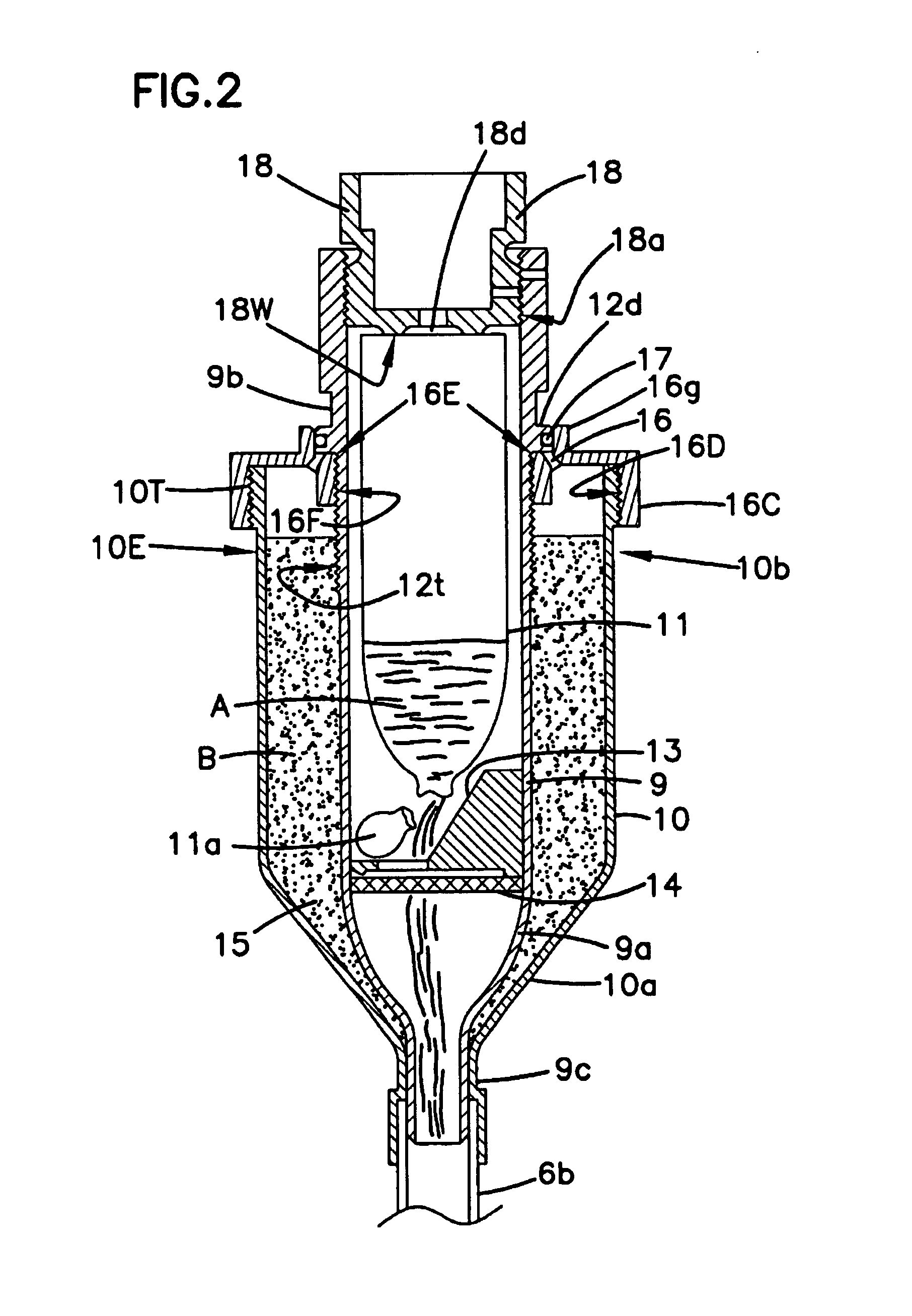Method and device for feeding components for bone cement into a mixing vessel
a technology of bone cement and components, which is applied in the direction of mixing methods, mixers, diagnostics, etc., can solve the problems of environmental harm and human health harm, and achieve the effect of avoiding the risk of gas releas
- Summary
- Abstract
- Description
- Claims
- Application Information
AI Technical Summary
Benefits of technology
Problems solved by technology
Method used
Image
Examples
first embodiment
[0034]The feed arrangement 1 of the first embodiment, shown in FIGS. 1-3, comprises an inner, essentially cylindrical container 9 communicating with the atmosphere and an outer, similar cylindrical container 10 which at least partially encloses the inner container. The container interior 9e is so arranged so as to enclose a glass ampoule 11 containing the liquid bone cement component A, and to communicate with the mixing vessel 2, via its agitator rod 6b, as already mentioned. The container 9 is integrally formed having a cylindrical collar 12 about its bottom end 9b with a threadable cap 18 capable of axial displacement relative to it. Removal of cap 18 allows insertion of ampoule 11 within interior 9e.
[0035]In the embodiment illustrated in FIG. 1, the facility for displacement to take place between the cylindrical collar 12 and the cap 18 is achieved by means of the internal collar threads 12a engaging the external cap threads 18a. The cap 18 has an opening 18d communicating betw...
third embodiment
[0037]The third embodiment in accordance with FIG. 6, shows that the only difference between this embodiment and the embodiments of FIGS. 4 and 5, is found in the brush-shaped devices 9d which are arranged as to make contact with the surface of the funnel-shaped part 10a in the first position of container 9. The bone cement component B is released from the aforementioned surface by relative rotation between the outer and inner containers such that trushes 10d, under weight of the powder, collapse and allow powder to fall into tube 6b.
[0038]A feed procedure of the above-described embodiments will now be summarized below with reference to FIGS. 1-6 of the drawings. It should be understood that with these embodiments, the feed arrangement is supplied ready for use, meaning it is filled with the bone cement components in the correct proportions.
[0039]As FIG. 1 illustrates, in order to permit feeding of the bone cement components into the mixing vessel 2 from the feed arrangement 1 in a...
fourth embodiment
[0042]In accordance with the fourth embodiment, FIGS. 7-11 show mixing vessel 2 as being pre-filled with the powder component of the bone cement. A tightening rod 19 is received within tubular agitator rod 6b of agitator 6 and has plug 19a and O-ring 19c inserted within a groove 19b thereof, to form an air-tight seal so that powdered contents B are not contacted by and affected by atmospheric air which is capable of downwardly travelling along tubular rod 6b to vessel bottom 4. Just prior to introducing glass ampoule 11 on top of mixing vessel 2, tightening rod 19 is completely removed from tube 6b, wherein the cylindrical container 9 is placed on top of vessel 2 by inserting funnel-shaped neck 9c into mouth 6c at the first end 6d of tubular rod 6b. Although FIGS. 1-6 show funnel-shaped top end 9a as having a slightly different contour from that of the same section shown in FIGS. 7-12, it should be understood that either contour can be used interchangeably in these embodiments. FIG....
PUM
| Property | Measurement | Unit |
|---|---|---|
| vacuum | aaaaa | aaaaa |
| optimal strength | aaaaa | aaaaa |
| displacement | aaaaa | aaaaa |
Abstract
Description
Claims
Application Information
 Login to View More
Login to View More - R&D
- Intellectual Property
- Life Sciences
- Materials
- Tech Scout
- Unparalleled Data Quality
- Higher Quality Content
- 60% Fewer Hallucinations
Browse by: Latest US Patents, China's latest patents, Technical Efficacy Thesaurus, Application Domain, Technology Topic, Popular Technical Reports.
© 2025 PatSnap. All rights reserved.Legal|Privacy policy|Modern Slavery Act Transparency Statement|Sitemap|About US| Contact US: help@patsnap.com



